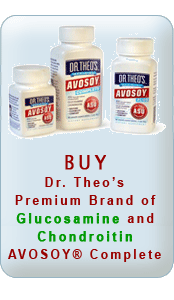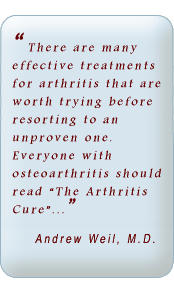Medical Evidence
Efficacy and Safety of Glucosamine Sulfate
in Osteoarthritis of the Spine: A Placebo-Controlled, Randomized,
Double-Blind Study. K.K. Fšrster, K. Schmid, G.
Giacovelli, L.C. Rovati. Dept. of Clinical Research, OPFERMANN
Arzneimittel GmbH, Wahl, Germany
Summary: Aim of the study
was to assess efficacy and safety of oral glucosamine sulfate
in the control of symptoms of cervical and/or lumbar spondylarthrosis
in comparison with placebo, over 6 weeks of treatment plus 4 weeks
of follow-up. The study was performed following a multicentre,
placebo-controlled, randomised, double-blind, parallel-group design
in patients with cervical and/or lumbar spondyloarthrosis, demonstrated
by pain and movement limitation for at least 6 months and positive
radiology. Clinic visits were performed at enrollment, after three
weeks, at the end of the 6 weeks of treatment (1,500 mg glucosamine
sulfate or placebo, once daily) as well as 4 weeks after drug
discontinuation. Main parameter of evaluation was the overall
judgement by the clinical investigator at the end of treatment,
secondary parameters were patient's global assessment, pain severity,
measured by a visual analogue scale (VAS), functional limitation,
measured by several functional tests, morning stiffness, interference
with daily activities, as well as, concerning safety, adverse
events and laboratory parameters.
Results: 160 patients were
enrolled (verum group: 66 women, 14 men. placebo group: 65 women,
15 men; mean age: 64.2 and 62.0 years, respectively) and completed
the study. 40 % of them showed cervical, about 40 % lumbar and
about 20 % both localizations of spondyloarthrosis. Concerning
the investigator's global judgement, 52.5 % glucosamine sulfate
patients were either "definetely improved" or "improved", vs 33.7
% of the placebo group patients (p=0.034). Concerning the patient's
global assessment, figures were higher: 67.5 % vs. 58.8 % (n.s.).
Glucosamine sulfate induced a more pronounced (in part, statistically
significant) decrease in severity of all pain parameters, and
this was maintained after drug discontinuation. A similar pattern
was found concerning movement limitation. Morning stiffness and
interference with daily activities was positively and in a greater
extent influenced by glucosamine sulfate. Tolerability was comparably
good (16. 3 % vs. 10.0 % mild and transient adverse events; n.s.).
Conclusions: As already well
established in osteoarthritis of the knee (Müller-Fab bender and
Bach 1990; Noack at al. 1994; Reichelt at al. 1994), glucosamine
sulfate has a significantly better symptomatic effect than placebo
in controlling pain and movement limitation in spondyloarthrosis.
This effect lasts on after discontinuation of treatment, whereby
safety of glucosamine sulfate all in all is good and comparable
to that of placebo.
Source: Osteoarthritis and
Cartilage (1999) 7 (supplement A), S32. ©1999 OsteoArthritis Research
Society International
Dr. Theo’s Comments: Here’s
yet another very well-designed study to prove that glucosamine
is effective, not only during the treatment, but for a period
of time afterwards.




